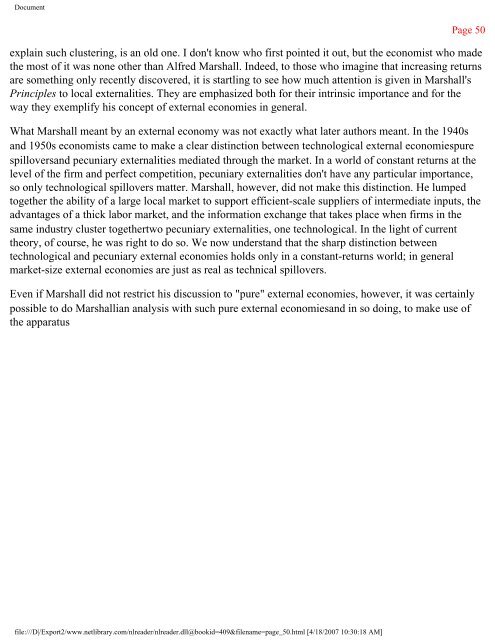Document file:///D|/Export1/www.netlibrary.com/nlreader/nlreader.dll ...
Document file:///D|/Export1/www.netlibrary.com/nlreader/nlreader.dll ...
Document file:///D|/Export1/www.netlibrary.com/nlreader/nlreader.dll ...
You also want an ePaper? Increase the reach of your titles
YUMPU automatically turns print PDFs into web optimized ePapers that Google loves.
<strong>Document</strong><br />
Page 50<br />
explain such clustering, is an old one. I don't know who first pointed it out, but the economist who made<br />
the most of it was none other than Alfred Marshall. Indeed, to those who imagine that increasing returns<br />
are something only recently discovered, it is startling to see how much attention is given in Marshall's<br />
Principles to local externalities. They are emphasized both for their intrinsic importance and for the<br />
way they exemplify his concept of external economies in general.<br />
What Marshall meant by an external economy was not exactly what later authors meant. In the 1940s<br />
and 1950s economists came to make a clear distinction between technological external economies pure<br />
spillovers and pecuniary externalities mediated through the market. In a world of constant returns at the<br />
level of the firm and perfect <strong>com</strong>petition, pecuniary externalities don't have any particular importance,<br />
so only technological spillovers matter. Marshall, however, did not make this distinction. He lumped<br />
together the ability of a large local market to support efficient-scale suppliers of intermediate inputs, the<br />
advantages of a thick labor market, and the information exchange that takes place when firms in the<br />
same industry cluster together two pecuniary externalities, one technological. In the light of current<br />
theory, of course, he was right to do so. We now understand that the sharp distinction between<br />
technological and pecuniary external economies holds only in a constant-returns world; in general<br />
market-size external economies are just as real as technical spillovers.<br />
Even if Marshall did not restrict his discussion to "pure" external economies, however, it was certainly<br />
possible to do Marshallian analysis with such pure external economies and in so doing, to make use of<br />
the apparatus<br />
<strong>file</strong>:///<strong>D|</strong>/Export2/<strong>www</strong>.<strong>netlibrary</strong>.<strong>com</strong>/<strong>nlreader</strong>/<strong>nlreader</strong>.<strong>dll</strong>@bookid=409&<strong>file</strong>name=page_50.html [4/18/2007 10:30:18 AM]
















